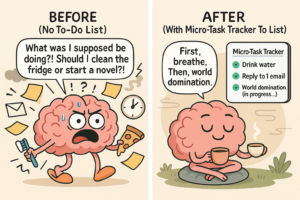The Ultimate 5-Minute Meditation for Relaxation and Focus Before Sleep

A good night’s sleep is essential for our overall well-being, yet winding down after a busy day can often be a challenge. This is where meditation comes in, offering a simple, effective way to relax and prepare your mind and body for restful sleep. In this article, we’ll explore the science behind meditation and sleep, walk you through a soothing 5-minute meditation script, and provide tips for enhancing your meditation practice.
The Science of Meditation and Sleep
Meditation has a profound impact on both the brain and body. It helps activate the parasympathetic nervous system, which promotes relaxation and reduces stress. Studies have shown that regular meditation can improve sleep quality, reduce insomnia, and enhance overall relaxation. By incorporating meditation into your nightly routine, you can create a peaceful transition from the busyness of the day to a state of restful sleep.
Preparation for the Meditation
Before starting your meditation, find a comfortable position. You can lie down in your bed or sit in a relaxed posture. Create an environment that promotes relaxation—dim the lights, ensure the space is quiet, and adjust the temperature to your comfort. Set an intention to relax and prepare for sleep.
The 5-Minute Meditation Script
Let’s walk through a detailed, 5-minute meditation designed to relax your body and focus your mind before sleep.
Minute 1: Settling In
Begin by taking a deep breath in through your nose, feeling your chest and abdomen expand. Hold for a moment, then slowly exhale through your mouth, releasing any stress or worry. With each breath, allow your body to sink deeper into comfort and relaxation.
Inhale deeply again, and as you exhale, imagine releasing any remaining tension from your muscles. Feel your body becoming heavy and grounded. Let your breath return to its natural rhythm, steady and calm.
Minute 2: Body Scan
Gently bring your awareness to the top of your head. Notice any sensations or areas of tension. With your next exhale, release any tightness you may feel.
Slowly move your attention down to your forehead, eyes, and jaw. Relax each area as you go. Allow your shoulders to drop, releasing any burdens you might be carrying. Feel your arms becoming limp and relaxed, right down to your fingertips.
Move your focus to your chest and heart area. Breathe into any tightness, and with your exhale, let it dissolve. Notice your abdomen rising and falling with each breath. Allow it to soften and relax completely.
Continue this gentle scan down through your hips, thighs, knees, calves, and feet. With each exhale, let go of any remaining tension, feeling your entire body now heavy, relaxed, and at ease.
Minute 3: Breathing and Centering
Now, bring your attention to your breath. Notice the cool air entering your nostrils and the warm air leaving your body. Each breath is a reminder of the present moment, anchoring you here and now.
With every inhale, imagine drawing in peaceful, calming energy. With every exhale, release any residual stress or negative thoughts. Continue this cycle, each breath bringing you deeper into a state of tranquility and stillness.
Minute 4: Visualization
Picture yourself in a serene, safe place. It could be a beach at sunset, a quiet forest glade, or a cozy room with a warm fire. Imagine the details vividly—the colors, the sounds, the sensations. Feel the peace and safety of this place enveloping you.
Spend a few moments here, basking in the serenity and comfort. Know that this is your sanctuary, a place you can return to whenever you need to find calm and relaxation.
Minute 5: Preparing for Sleep
As we draw this meditation to a close, take one final deep breath in, filling your lungs completely. Hold for a moment, and then exhale fully, letting go of any lingering tension.
Set a gentle intention for your sleep, perhaps wishing for restful, restorative slumber, or pleasant dreams. Trust that your body and mind will continue to relax as you drift off to sleep.
When you’re ready, slowly open your eyes if they were closed, or simply remain where you are if you’re already lying down. Allow yourself to transition gently into sleep, carrying this sense of calm and focus with you.
Sweet dreams, dear one. Namaste.
Benefits of Regular Practice
Incorporating this 5-minute meditation into your nightly routine can have long-term benefits. Regular practice can lead to improved sleep quality, reduced insomnia, and enhanced overall well-being. Both psychological and physical health can see positive changes, fostering a more balanced and peaceful life.
Tips for Enhancing the Meditation Experience
- Consistency is Key: Try to meditate at the same time each night to establish a routine.
- Combine with Other Relaxation Techniques: Enhance your experience by taking a warm bath or doing gentle stretching before meditation.
- Use Guided Meditation Apps or Recordings: These can provide additional structure and support, making it easier to stay focused.
Conclusion
Taking a few moments to meditate before bed can transform your nightly routine, helping you relax and prepare for a restful sleep. By following this simple 5-minute meditation script, you can create a serene transition to slumber, promoting better health and well-being. Prioritize this practice, and enjoy the benefits of peaceful, restorative sleep.
Additional Resources
For further guidance and personalized meditation coaching, consider exploring the following resources:
- Books on Meditation and Sleep: “The Sleep Solution” by W. Chris Winter, “The Headspace Guide to Meditation and Mindfulness” by Andy Puddicombe.
- Meditation Apps: Headspace, Calm, Insight Timer.
- Websites and Articles: Mindful.org, SleepFoundation.org.




